



Added 3 September 2006
Day 2: Wednesday, June 7, 2006
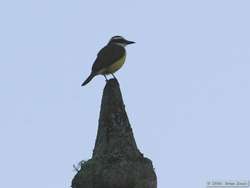 Today was a very good day. We started at 6:30 a.m. at the front of the church and did a little bit of birding near the front of the church before walking a short ways down the hill. We were only making use of the good light and prime birding time before we could have breakfast at 7:30, so we didn't go very far.
Today was a very good day. We started at 6:30 a.m. at the front of the church and did a little bit of birding near the front of the church before walking a short ways down the hill. We were only making use of the good light and prime birding time before we could have breakfast at 7:30, so we didn't go very far. 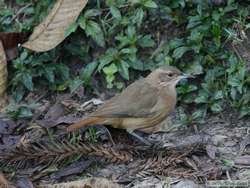 We saw a few interesting birds, then had a really nice breakfast. After breakfast, we went on a longer hike. The plan was to walk down the road to a trail and go birding there. We did do that, but we saw so many new and beautiful birds just on the road, that it took us well over an hour to walk the half kilometer or so to the trail.
We saw a few interesting birds, then had a really nice breakfast. After breakfast, we went on a longer hike. The plan was to walk down the road to a trail and go birding there. We did do that, but we saw so many new and beautiful birds just on the road, that it took us well over an hour to walk the half kilometer or so to the trail.
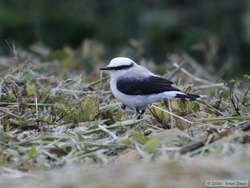
|

|

|
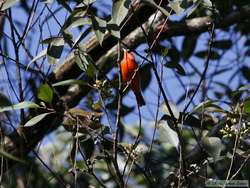
|
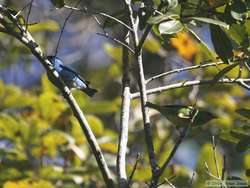
|
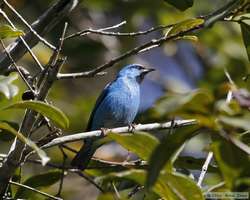
|
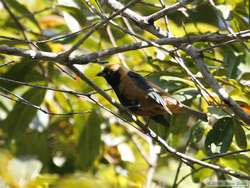
|
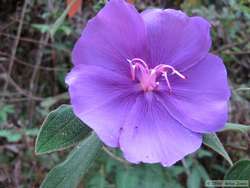
|
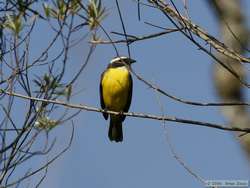
|
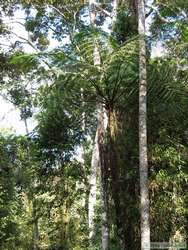
|
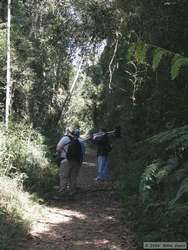
|
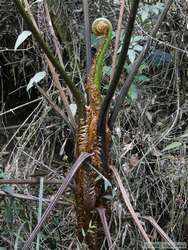
|

|
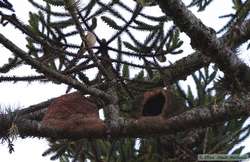
|
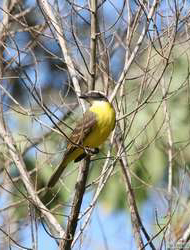
|
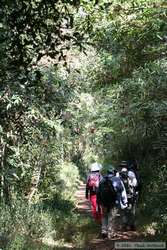
|
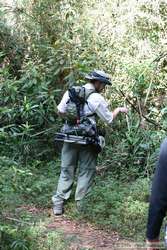
|


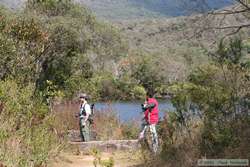 By the time we actually got to the trail, it was late enough in the morning that the birds were not as plentiful. We ended at a man-made lake called Tanque Grande and relaxed there for a while before starting the return trek.
By the time we actually got to the trail, it was late enough in the morning that the birds were not as plentiful. We ended at a man-made lake called Tanque Grande and relaxed there for a while before starting the return trek.
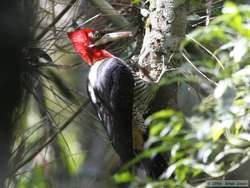
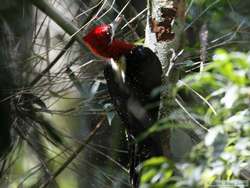 On the way back, we weren't seeing much at all when Chuck spotted a robust woodpecker (Campephilus robustus) near the trail. We watched and photographed it for some time before it finally flew away.
On the way back, we weren't seeing much at all when Chuck spotted a robust woodpecker (Campephilus robustus) near the trail. We watched and photographed it for some time before it finally flew away.
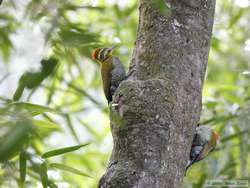
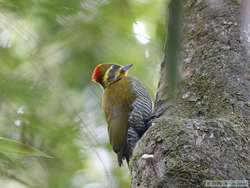 Next, Shan spotted a much less robust white-browed woodpecker (Piculus aurulentus), which was also gorgeous. Since leaving Tanque Grande, we had been hearing monkeys off in the forest. When once they sounded quite close, Fabricio, Dave, Shan and I headed up the hill in hot pursuit. After fighting our way through the thick vegetation crowding a little used trail, we got a fleeting glimpse of a masked titi monkey (Callicebus personatus). Begrudgingly, we headed back down the hill. Once back on the main trail, we found Chuck taking pictures of a troop of Masked Titi Monkeys that he'd been watching for some time. What a punk! The monkeys were quite a ways up into the trees, but we got some pretty good looks at them.
Next, Shan spotted a much less robust white-browed woodpecker (Piculus aurulentus), which was also gorgeous. Since leaving Tanque Grande, we had been hearing monkeys off in the forest. When once they sounded quite close, Fabricio, Dave, Shan and I headed up the hill in hot pursuit. After fighting our way through the thick vegetation crowding a little used trail, we got a fleeting glimpse of a masked titi monkey (Callicebus personatus). Begrudgingly, we headed back down the hill. Once back on the main trail, we found Chuck taking pictures of a troop of Masked Titi Monkeys that he'd been watching for some time. What a punk! The monkeys were quite a ways up into the trees, but we got some pretty good looks at them.
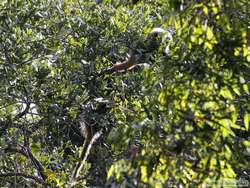
|
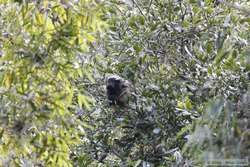
|
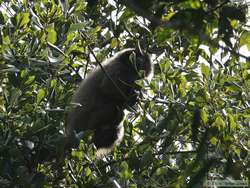
|
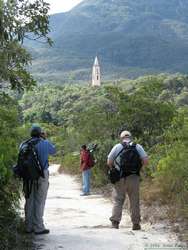 It was mid-day at this point, and we were all starting to get hungry, so we walked back to camp, picking up a few new species along the way, feeling really happy about how the day was shaping up. We saw lots of birds, and our first primate!
It was mid-day at this point, and we were all starting to get hungry, so we walked back to camp, picking up a few new species along the way, feeling really happy about how the day was shaping up. We saw lots of birds, and our first primate!
 We were late getting back to the monastery for lunch, but there was plenty left for us when we arrived. We had a couple of hours to kill between the end of lunch and our next hike at 3:30, so we decided to explore the picturesque monastery that we found ourselves so fortunate to be staying at. Shan and I roamed together, and Chuck and Dave roamed together. Shan and I wandered in or through just about every place that wasn't behind a closed door, including the catacombs and an old burned out school building that had been basically enclosed with glass and turned into a museum. The museum didn't seem to have an overarching purpose except to display old things. Though hard to describe, the museum did have some interesting items. We also wandered around the church itself, admiring the beautiful stained glass and other ornamentation.
We were late getting back to the monastery for lunch, but there was plenty left for us when we arrived. We had a couple of hours to kill between the end of lunch and our next hike at 3:30, so we decided to explore the picturesque monastery that we found ourselves so fortunate to be staying at. Shan and I roamed together, and Chuck and Dave roamed together. Shan and I wandered in or through just about every place that wasn't behind a closed door, including the catacombs and an old burned out school building that had been basically enclosed with glass and turned into a museum. The museum didn't seem to have an overarching purpose except to display old things. Though hard to describe, the museum did have some interesting items. We also wandered around the church itself, admiring the beautiful stained glass and other ornamentation.

|

|

|

|

|
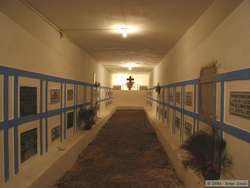
|

|
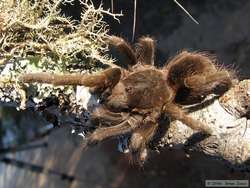 At 3:30, we were hiking again, this time on a trail that started from the grounds of the monastery directly. For quite some distance, the biggest excitement we had was a handful of wolf tracks and a large black spider that looked like a tarantula.
At 3:30, we were hiking again, this time on a trail that started from the grounds of the monastery directly. For quite some distance, the biggest excitement we had was a handful of wolf tracks and a large black spider that looked like a tarantula.  We also saw some maned wolf tracks. I checked them out, thinking it quite likely that they might be as close as I'd get to seeing maned wolves. With the near total absence of birds, I was worried that the afternoon hike would prove anti-climatic compared to the morning hike. That was before Fabricio spotted a family of black tufted-eared marmosets (Callithrix penicillata) in a tree not 3 meters from the trail. We stayed and photographed the marmosets for quite some time.
We also saw some maned wolf tracks. I checked them out, thinking it quite likely that they might be as close as I'd get to seeing maned wolves. With the near total absence of birds, I was worried that the afternoon hike would prove anti-climatic compared to the morning hike. That was before Fabricio spotted a family of black tufted-eared marmosets (Callithrix penicillata) in a tree not 3 meters from the trail. We stayed and photographed the marmosets for quite some time. 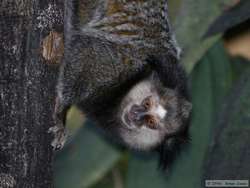 While there, we were visited by a gorgeous violet capped woodnymph (Thalurania glaucopis) and a masked yellowthroat (warbler) (Geothlypis aequinoctialis). Fabricio told us that these marmosets are endangered and very rare. It was only the second time he'd ever seen them, so we were extremely lucky to see them.
While there, we were visited by a gorgeous violet capped woodnymph (Thalurania glaucopis) and a masked yellowthroat (warbler) (Geothlypis aequinoctialis). Fabricio told us that these marmosets are endangered and very rare. It was only the second time he'd ever seen them, so we were extremely lucky to see them.
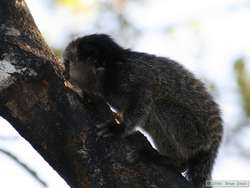
|
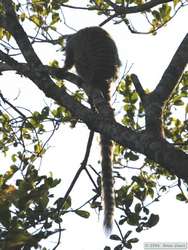
|
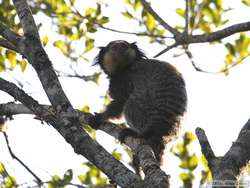
|
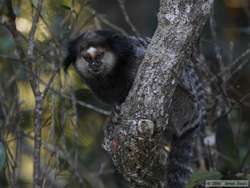
|
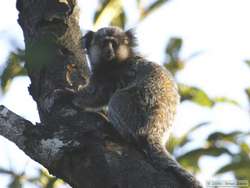
|
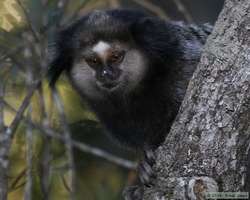
|

|
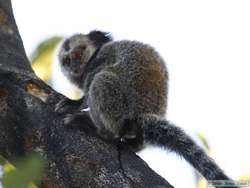
|

|

 Even while watching the marmosets, we amazed at the violet-capped woodnymph (Thalurania glaucopis). Surprisingly, the hummingbird was also there for the sap. I never thought that a hummingbird would eat sap. If you look closely at the end of the video, you will see the violet-capped woodnymph flitting about.
Even while watching the marmosets, we amazed at the violet-capped woodnymph (Thalurania glaucopis). Surprisingly, the hummingbird was also there for the sap. I never thought that a hummingbird would eat sap. If you look closely at the end of the video, you will see the violet-capped woodnymph flitting about.
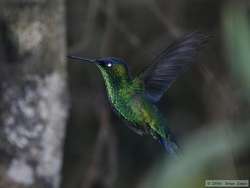
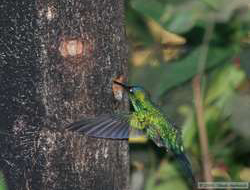 The marmosets were so oblivious of us that we joked that Fabricio had radioed ahead to have someone release them from a cage for us. When we returned to the monastery, very happy indeed, we told Fabricio that he could call the monkey-handler to get collect his marmosets again.
The marmosets were so oblivious of us that we joked that Fabricio had radioed ahead to have someone release them from a cage for us. When we returned to the monastery, very happy indeed, we told Fabricio that he could call the monkey-handler to get collect his marmosets again.
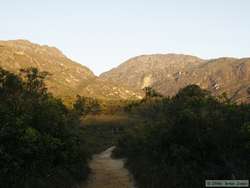
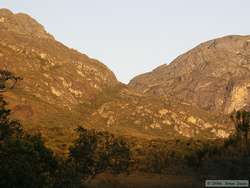 We got back to our rooms right at dark and got cleaned up a bit before dinner, yet another meal so good that we all gorged ourselves. I held back a little bit though, because only Fabricio, Marclei and I knew that birthday cake was on the menu. The previous day, Fabricio took me aside and told me that he noticed from our fact sheets that Shan's birthday was June 7th, and wanted to know if it would be ok if he had Marclei go in to town to get a birthday cake for her. Of course I said that would be fine, and thought it very nice of him to even suggest the idea.
We got back to our rooms right at dark and got cleaned up a bit before dinner, yet another meal so good that we all gorged ourselves. I held back a little bit though, because only Fabricio, Marclei and I knew that birthday cake was on the menu. The previous day, Fabricio took me aside and told me that he noticed from our fact sheets that Shan's birthday was June 7th, and wanted to know if it would be ok if he had Marclei go in to town to get a birthday cake for her. Of course I said that would be fine, and thought it very nice of him to even suggest the idea.
After the main meal, but before Marclei got the birthday cake, Shan kept wanting to get whatever desert they had that evening, but I kept trying to prevent her from going. She looked at me strangely for doing so, but had no clue what was going on. When Marclei brought the cake out Shan was extremely surprised and kept thanking me. I'd remind her that the cake was all Fabricio's idea and Marclei's doing, at which point she would thank them again. Even before we had all gotten our cake, she insisted on sharing the cake with everyone around, which included a handful of other guests and some of the kitchen staff. It was a very endearing gesture on her part, and an example of one of the reasons why I love her. Fabricio and Marclei scored a lot of bonus points with Shan, and even more with me. She'd remarked at how good her birthday had been all day, but the cake was an unexpected (and delicious!) bonus that really topped it all off.
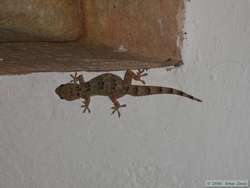 After dinner, we all congregated in the elevated front patio area in front of the church to wait for the maned wolves (Chrysocyon brachyurus) again. Since it was my last chance, and disappointed in my lack of resolve the previous night, I vowed to stay up much later, indeed all night if necessary, to see the wolves. The evening started out with quite a few people waiting on another chilly, if not cold, night. Marclei went inside before nine. By a little after nine o'clock, Chuck and Dave called it quits. Not long after, Shan went to bed and Fabricio was the next to drop about 30 minutes later. That left me and a few folks who weren't in our group. By 10:15, I was all by myself, with people occasionally dropping by to check in.
After dinner, we all congregated in the elevated front patio area in front of the church to wait for the maned wolves (Chrysocyon brachyurus) again. Since it was my last chance, and disappointed in my lack of resolve the previous night, I vowed to stay up much later, indeed all night if necessary, to see the wolves. The evening started out with quite a few people waiting on another chilly, if not cold, night. Marclei went inside before nine. By a little after nine o'clock, Chuck and Dave called it quits. Not long after, Shan went to bed and Fabricio was the next to drop about 30 minutes later. That left me and a few folks who weren't in our group. By 10:15, I was all by myself, with people occasionally dropping by to check in.
I moved from the cold steel benches to the front steps of the church, which were equally cold, but a little more sheltered from the breeze. Not expecting anyplace in Brazil to be cold, I didn't bring warm enough clothes for sitting out all night, but the blanket Shan brought me helped. I was still chilled though, not to mention tired.
Shortly before 11:00 p.m., Shan came back out saying she thought she had heard the wolves. Unfortunately, I had seen neither hide nor hair of the wolves. Shan wanted to wait with me for them, but also didn't want to freeze, the main reason for her leaving earlier, but we figured out a way for us to share a blanket and we waited for a while together. Our combined body heat made me warm enough that I started to nod off a bit.
When Shan said "There he is!" and I opened my eyes, it took a second for my brain to register the Maned Wolf quietly cresting the top of the stairs. Since, as explained before, I wasn't really expecting to get lucky enough to see one, I was only half-prepared for the wolf's arrival. I managed to get my wits about me pretty quickly though and started taking pictures while Shan took video. I had to first switch to taking shots on my camera on manual focus since the light was so low. Then I had to switch Shan's camcorder to night mode for her.
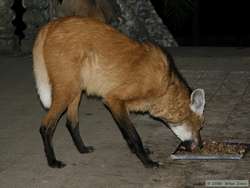 The wolf grabbed and ate a couple of pieces of chicken, and fairly quickly left. With all of the fiddling with cameras, we only got a half-dozen shots and a small amount of video footage, which I'd hoped I didn't wreck with the excited shaking my leg was doing. (As it turns out, the video was pretty pointless anyway since it was so dark.) After he disappeared down the stairs, Shan waited with me until midnight to see if he would come back. He never did, but I decided to wait it out a little bit longer. I had my laptop with me and worked on this journal to help stay awake. Approaching two o'clock in the morning, despite the now rather intense feeling of being cold, I could stay awake no longer. By morning, all of the food left out for the wolves was gone. They had returned after I went to bed. But at least I got one, albeit fleeting, look at one of the world's most endangered animals.
The wolf grabbed and ate a couple of pieces of chicken, and fairly quickly left. With all of the fiddling with cameras, we only got a half-dozen shots and a small amount of video footage, which I'd hoped I didn't wreck with the excited shaking my leg was doing. (As it turns out, the video was pretty pointless anyway since it was so dark.) After he disappeared down the stairs, Shan waited with me until midnight to see if he would come back. He never did, but I decided to wait it out a little bit longer. I had my laptop with me and worked on this journal to help stay awake. Approaching two o'clock in the morning, despite the now rather intense feeling of being cold, I could stay awake no longer. By morning, all of the food left out for the wolves was gone. They had returned after I went to bed. But at least I got one, albeit fleeting, look at one of the world's most endangered animals.
What a phenomenal day!
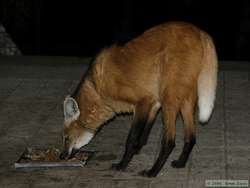 I think a few words about the maned wolf (Chrysocyon brachyurus) are in order here. To begin with, it isn't truly a wolf, though it is a canid. It is the only species in the genus Chrysocyon. The maned wolf reaches a size of about 1.5 meters (5 feet) long and 1 meter (3.3 feet) tall. Maned wolves do not hunt large prey. Most of their diet consists of small animals, grass, and fruit, the later of which may constitute up to 60% of their diet at times. They also prey on, unfortunately, domestic chickens. And this is where they get into trouble.
I think a few words about the maned wolf (Chrysocyon brachyurus) are in order here. To begin with, it isn't truly a wolf, though it is a canid. It is the only species in the genus Chrysocyon. The maned wolf reaches a size of about 1.5 meters (5 feet) long and 1 meter (3.3 feet) tall. Maned wolves do not hunt large prey. Most of their diet consists of small animals, grass, and fruit, the later of which may constitute up to 60% of their diet at times. They also prey on, unfortunately, domestic chickens. And this is where they get into trouble.
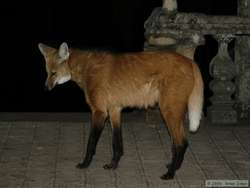 As with all of the natural areas in the world, the Atlantic Rainforest continues to suffer from the encroachment of human beings further and further into the once wild lands. This puts people and animals into more and more direct conflict with one another. Few species suffer from this conflict more than the large predators. The Maned wolf is no exception. They have been forced into ever smaller pieces of land and thus forced to rely on less resources to survive. In such a situation, it is all but inevitable that they turn to eating whatever they can, including domestic chickens. People, naturally not wanting to have all of their chickens killed, then kill the wolves.
As with all of the natural areas in the world, the Atlantic Rainforest continues to suffer from the encroachment of human beings further and further into the once wild lands. This puts people and animals into more and more direct conflict with one another. Few species suffer from this conflict more than the large predators. The Maned wolf is no exception. They have been forced into ever smaller pieces of land and thus forced to rely on less resources to survive. In such a situation, it is all but inevitable that they turn to eating whatever they can, including domestic chickens. People, naturally not wanting to have all of their chickens killed, then kill the wolves.
The combination of habitat fragmentation and wolf-human conflict has lead to the severe decline of the wolves, leading the IUCN (The World Conservation Union) to declare them as a vulnerable species. There are only an estimated 2200-4500 wolves left throughout their range, which includes Brazil, northern Argentina, Paraguay, eastern Bolivia and southeastern Peru.
As with most predators, it is believed that they hold a certain supernatural powers, and the maned wolf is no different. The right eye of the wolves is supposed to bring good luck in gambling, and a child wearing a maned wolf tooth in a necklace is supposedly protected against future dental problems. The use of body parts for these supernatural purposes also constitutes a threat to their existence.
The wolf has been classified as endangered throughout most of its range, and is legally protected in Brazil, though to what effect, I don't know.
As for the wolf itself, it is primarily a nocturnal animal. The wolves' long legs allow them to see better in tall grass, where they are often found, and they can splay their toes to increase the size of their feet and help them walk on marshy ground without sinking in the mud. Maned wolves are monogamous and defend a shared territory (thought to be usually about 11 square miles in size), but are generally solitary animals except during the mating season.
Species list for the day (46 birds, 3 mammals):
Least Grebe (Tachybaptus dominicus)
Black Vulture (Coragyps atratus)
Crested Caracara (Polyborus plancus)
Yellow-headed Caracara (Milvago chimachima)
Red-throated Piping-Guan (Pipile cujubi)
Dusky-legged Guan (Penelope obscura)
Ferruginous Pygmy-Owl (Glaucidium brasilianum)
Black Jacobin (Melanotrochilus fuscus)
Violet-capped Woodnymph (Thalurania glaucopis)
White-barred Piculet (Picumnus cirratus)
Lineated Woodpecker (Dryocopus lineatus)
Robust Woodpecker (Campephilus robustus)
White-browed Woodpecker (Piculus aurulentus)
Olivaceous Woodcreeper (Sittasomus griseicapillus)
Rufous Hornero (Furnarius rufus)
Wing-banded Hornero (Furnarius figulus )
Variable Antshrike (Thamnophilus caerulescens)
Blue (Swallow-tailed) Manakin (Chiroxiphia caudata)
Greenish Tyrannulet (Phyllomyias virescens)
Southern Beardless-Tyrannulet (Camptostoma obsoletum)
Yellow-olive Flycatcher (Tolmomyias sulphurescens)
White-rumped Monjita (Xolmis velata)
E Velvety Black-Tyrant (Knipolegus nigerrimus)
Masked Water-Tyrant (Fluvicola nengeta)
Long-tailed Tyrant (Colonia colonus)
Three-striped Flycatcher (Conopias trivirgata)
Great Kiskadee (Pitangus sulphuratus)
White-rumped Swallow (Tachycineta leucorrhoa)
Blue-and-white Swallow (Notiochelidon cyanoleuca)
House Wren (Troglodytes aedon)
Rufous-bellied Thrush (Turdus rufiventris)
Masked Yellowthroat (Geothlypis aequinoctialis)
Golden-crowned Warbler (Basileuterus culicivorus)
Black-faced Tanager (Schistochlamys melanopis)
Sayaca Tanager (Thraupis sayaca)
Palm Tanager (Thraupis palmarum)
E Gilt-edged Tanager (Tangara cyanoventris)
Burnished-buff Tanager (Tangara cayana)
Blue Dacnis (Dacnis cayana)
Swallow-Tanager (Tersina viridis)
Black-goggled Tanager (Trichothraupis melanops)
Golden-chevroned Tanager (Thraupis ornata)
Brazilian Tanager (Ramphocelus bresilius)
Rufous-collared Sparrow (Zonotrichia capensis)
Red-rumped Cacique (Cacicus haemorrhous)
Crested Oropendola (Psarocolius decumanus)
E Black Tufted-eared Marmoset (Callithrix penicillata)
E Masked Titi Monkey (Callicebus personatus nigrifrons)
Maned Wolf (Chrysocyon brachyurus)
 |
 |